Japan’s many volcanoes may be a source of anxiety when they occasionally come to life. But constant geothermal activity has a much more welcome side effect: onsen.
Hot springs in Japan were once used almost exclusively for public bathing during the country’s feudal period, but contemporary onsen are more private affairs, where every year millions of Japanese strip off and slip into a pool of mineral-rich water in the company of friends or family.
The object is not to wash away the grime, but to relax, forget about the stresses of city life and benefit from the water’s supposed therapeutic qualities. To spend a night at an onsen is to get a feel for the Japan modernity has left behind.
Soak in
Onsen come in an eclectic range of sizes and styles: from the tiny pools of steamy water tucked away along a coastline to more abundant sources that support a local tourist industry.
The immutable appeal of bathing in naturally heated water sends millions of Japanese to onsen resorts every year. The range of options is big enough to cater to a couple on a romantic weekend getaway, a family enjoying a short holiday and groups of colleagues for whom a night at a traditional inn, baths included, is a rare opportunity to bond away from the workplace.
While the ceaseless quest for convenience has spawned the rise of urban hot spring complexes for day-trippers, an overnight trip to a ryokan – a traditional inn complete with onsen baths, is the only way to properly sample the waters, eat fresh and locally sourced cuisine, and take a step back into a Japan of another era.
It would be hard to find a Japanese who doesn’t relish the prospect of changing out of everyday clothes and into a cotton yukata – a type of informal kimono – and tucking into a multiple-course kaiseki meal before drifting off to sleep on an expertly prepared futon.
To qualify as an onsen, the location’s water must contain at least one of 19 legally designated chemical elements. It is the geothermal quality that sets onsen apart from urban public bathhouses, known as sento, that are fed by nothing more sophisticated than piping hot tap water. Onsen water must also emerge from the ground at a minimum of 25 degrees centigrade before it is reheated.
Healing power
There is still some debate surrounding the possible health-giving qualities of bathing in onsen, but many devotees swear that prolonged and regular soaks can ease arthritis, becalm skin complaints or simply soothe away aches and pains.
Robert Neff, a long-time Japan resident and author of Japan’s Hidden Hot Springs, says he goes to onsen for relaxation rather than for any supposed medical benefits.
“I don’t say they have no therapeutic value, but that’s not why I go,” Neff says.
“That said, onsen do have true, honest mineral content. You can feel it when you get in. And it’s true that part of the Japanese medical establishment recognises their therapeutic value.”
Observing the rules of bathing Japanese-style, let alone avoiding culinary faux pas when presented with a meal of myriad dishes can seem like a cultural step too far for the short-term visitor.
But growing interest in onsen among international businesspeople, and a willingness among most ryokan owners to welcome non-Japanese guests, means the hot-spring experience almost always ends happily (see guide to onsen etiquette).
Neff urges the international business traveller to dismiss any misgivings and embrace the opportunity to experience the “real Japan”.
“The great thing about onsen is that, if you choose carefully, it’s the perfect way to relax at the end of a working trip,” he says. “They offer great relaxation, great food and an experience of the kind of Japan you almost certainly wouldn’t see if you stayed in Tokyo or Osaka. You’ll be treated with kindness and solicitude, and all in the midst of great nature.”
He adds: “Ryokan are more welcoming towards foreigners these days and some have staff that can speak a little English. I’ve never heard of anyone coming away feeling that they’ve been misunderstood. Quite the opposite.”
Be a guest
For the foreign visitor to the Osaka area, a good place to start is Arima, one of Japan’s oldest and most popular onsen resorts. Tucked away in the foothills of Mount Rokko, the town is nevertheless within easy reach of Osaka by train or bus.
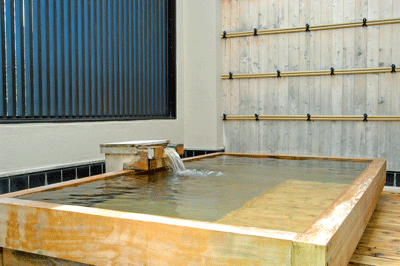
Arima’s waters are steeped in history. Prominent Buddhist monks are believed to have recognised their restorative qualities as early as the 7th century; and by the 16th century the town was closely associated with warlord Hideyoshi Toyotomi, a regular visitor.
He, like millions of people today, was drawn by Arima’s “kinsen” (radium spring) – a yellowy-brown water packed with iron and salt that is said to be effective against rheumatism and menopausal conditions; and “ginsen” (silver spring), a clear, carbonic acid spring that bathers laud for its ability to smooth away rough skin.
There are more than 20 hotels and inns to choose from, including Arima Gyoen, one of the better-known establishments, located a short walk from Arima Onsen train and bus stations.
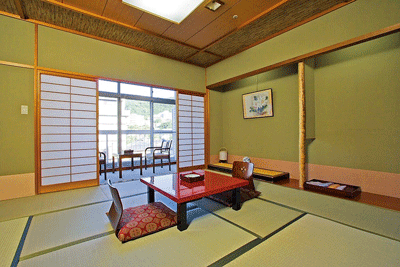
Despite its modern appearance, Arima Gyoen’s (www.arima-gyoen.co.jp) Japanese rooms have the same traditional feel you’d find in a smaller countryside inn: tatami mats, sliding paper doors and a large, low table that forms the centrepiece of the minimal interior décor.
Some ryokan serve dinner in dining areas, but the norm is to eat it in your own room, safe in the knowledge that by the time you return from a postprandial stroll or dip in the bath, your table will have been cleared and a futon laid out in its place.
Traditionally, a ryokan meal depends heavily on local, seasonal produce, all presented on carefully selected crockery in a style known as kaiseki. An Arima Gyoen meal typically comprises well over a dozen separate items, including tuna, squid and yellowtail sashimi, sweet potato, a sliver of eel wrapped around burdock, seafood and vegetable tempura, octopus carpaccio, whole grilled scallops, rice, soup and the highlight: thin slices of marbled beef – a local delicacy – cooked shabu shabu-style in a gently bubbling broth along with tofu and vegetables.
Despite the sheer variety of food, the dishes are light enough not to diminish the attractions of a second trip to the communal baths before bed.
Arima Gyoen’s communal bathing areas are segregated, but both contain the waters for which the town is famous. I tentatively dipped a toe into the clear water of the ginsen bath, and was pleased to find it was not nearly as hot as I’d imagined. But it is the adjoining kinsen bath that most visitors come for. The water offers zero visibility, has high salt content and a pronounced whiff of iron.
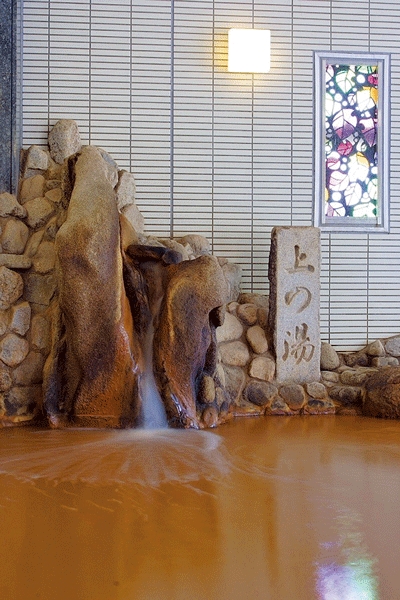
My bathing session ended with a few minutes spent reclining in an open-air bath made from Japanese cypress. The view is slightly obscured by a fence protecting guests from prying eyes, but even so, there can be few better onsen experiences than being cradled by the natural heat, the air filled with the scent of wood, as you watch your breath slice through the cold night air.
It is worth spending at least half a day in Arima exploring its cultural and historical sites. The town is home to several important temples and shrines, including Gokuraku-ji, where a bathhouse built for Toyotomi Hideyoshi was unearthed during renovations in 1996.
The hilly, quiet streets are a walker’s dream, and you are never far from souvenir shops and stalls selling, among other gifts, tansan senbei – sweet crackers made with carbonated spring water. A personal favourite is the local cider, a slightly sweet, non-alcoholic drink made from local water.
A train ride away
Tokyo is within reach of several famous onsen resorts, but Atami enjoys the added benefit of being accessible by bullet train from the capital in under an hour. As onsen locations go, Atami – meaning “hot ocean” – is hard to beat. Perched on the side of a partly submerged volcanic caldera overlooking Sagami Bay, the town has been a popular bathing venue since the 8th century.
Be warned, however, that Atami’s popularity, particularly during the postwar boom years, turned the area into a busy resort of dozens of hotels and big ryokan, not all of them pleasing to the eye. But what it loses a little in architectural overkill, it makes up for in the quality of its water, seafood, and proximity to the capital.
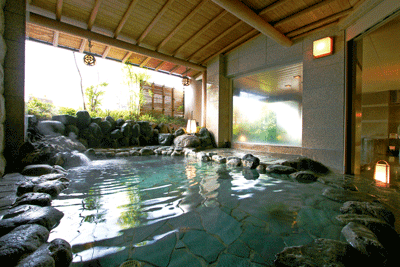
Atami Juraku Hotel (www.atami-juraku.co.jp/english/e-index.html) boasts one member of staff for every three visitors, a wide selection of Japanese- and Western-style rooms, baths and – a plus for the English-speaking guest – a president who graduated from Cornell University.
I again opted for Japanese-style accommodation among Juraku’s 36 rooms and was pleased to find that, due to its location along a lofty coastal road, even my first-floor room had an ocean view.
The kaiseki dinner and breakfast relied heavily on local seafood, particularly the semi-dried himono (fish) variety that can be seen hanging outside around the town.
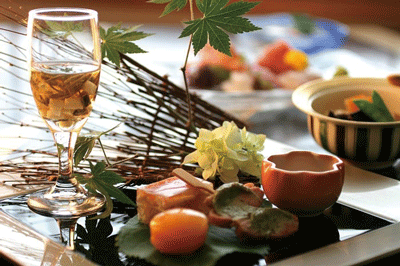
The water at Juraku is slightly salty and enters the baths at around 42 degrees centigrade. It is renowned for its ability to warm the body quickly and thoroughly, even in the depths of winter. I sampled the main baths after dinner and, after a breakfast of dried fish, pickles, miso soup and rice – a quintessential ryokan fare – spent part of the following morning in a private wooden bath that can be reserved the previous evening.
While it can no longer match the high-growth years of the postwar period, Atami is still home to more than 100 hotels and ryokan, and attracts almost 3 million visitors a year.
“The number of foreign guests is increasing,” says Juraku president Kanekiyo Morita, whose grandfather opened the establishment in 1955. “We would certainly welcome more. Here, they can get a good taste of Japan, delicious food and a comfortable sleep on a tatami floor.”
Etiquette
The one non-negotiable rule of onsen bathing is that no ablutions should be performed in the bath itself. Make sure you shower and rinse away all soap and shampoo before getting in, and try not to splash your neighbor in the process.
Bathers are usually not permitted to wear swimsuits. Most onsen provide small towels that offer strategic cover when walking around the changing room or from one bath to the other.
It’s not unknown for bathers to strike up conversation in the bath, but for the most part, you’ll be left alone. And one final word of advice: despite their size, onsen should never be confused with swimming pools.
Right in town
Travellers who lack the time or budget to venture to Atami, Arima or other onsen resorts need not despair. There are many city onsen ideal for spending a few hours recuperating before the trip back home. They are all clean and convenient, if lacking the charm and tranquility of the out-of-town onsen experience.
Osaka Spa World
A wide range of themed baths, from those modeled on the springs of ancient Rome to a Spanish-style open-air footbath and a Japanese onsen.
www.spaworld.co.jp/english/service.html
Toshimaen Niwa no Yu
Located in Tokyo’s Nerima ward, near the busy district of Ikebukuro. The facility’s water is pumped from 1,445 metres below ground into themed indoor and outdoor baths. Mixed bathing is possible, but you need to wear a swimsuit.
www.toshimaen.co.jp (Japanese)
Oedo Onsen Monogatari
As its name suggests, this complex on Odaiba island off the shore of Tokyo Bay takes its cue from the Edo period (1603-1868) and features a selection of segregated baths.
www.ooedoonsen.jp (Japanese)
Machida Roten Garden
The water in this understated daytrip onsen is fed into several indoor and outdoor baths at a very comfortable 37.2 degrees centigrade.
www.roten-garden.com (Japanese)
Yukari Jindaiji Onsen
The complex features baths containing 12 minerals, an Edo-style stone sauna, Japanese food and tatami mats to snooze on post-bath. An English-language PDF explainer can be accessed from the website’s front page.
www.shiroyama-gr.co.jp/yukari/home/index.html?cont=info (Japanese)








